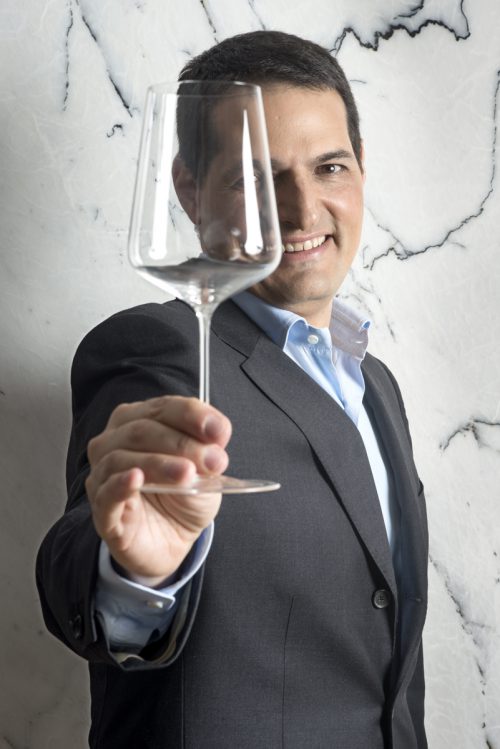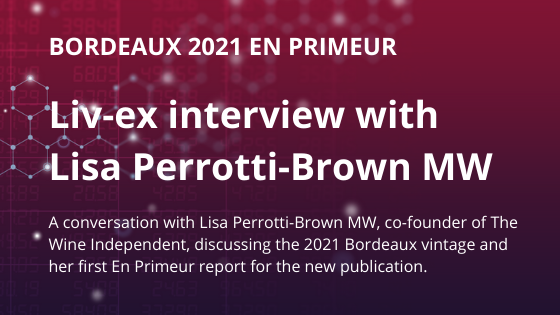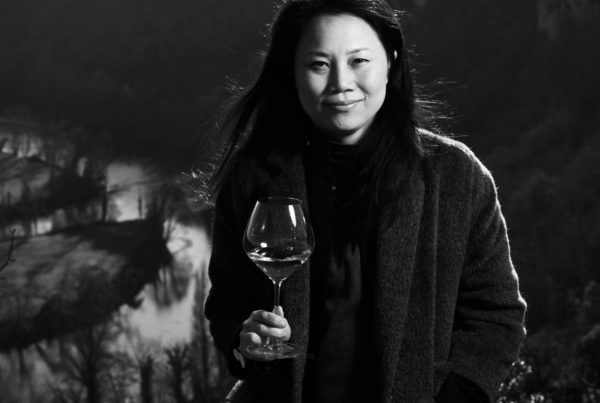
Antonio Galloni is founder and CEO of Vinous, a leading wine publication, for which he also reviews the wines of Bordeaux, California, Northern Italy, and Champagne. Liv-ex previously interviewed Galloni in 2013. Since then, Vinous has acquired Stephen Tanzer’s International Wine Cellar (another leading publication) and Delectable, a wine ratings app. In May, he kindly made time to catch up with Liv-ex’s, Sarah Phillips, for this interview. In part one, below, he discusses his impressions of Bordeaux 2017, his role at Vinous and Delectable, and his recent hire of critic Neal Martin. Part two will be published next week.
You recently returned from Bordeaux where you tasted the 2017s. You were the only critic to explicitly call it a Right Bank vintage…
For me, 2017 is very clearly a Right Bank vintage. Obviously, the vintage is marked by a very serious frost event, which inherently creates uncertainty. It’s clearly not a great vintage across the board – it’s just a very good vintage with some highlights – and because of this, I think people are very afraid to take a view that is out of the consensus. It’s too risky. One of the most important things I learned from Bob Parker was to have the confidence to trust my palate and to write with conviction. Here in London, a highly respected taster and professional whom I am sure you know told me recently “I thought it was a Right Bank vintage too, but I didn’t have the balls to say it.”
So, when I think about the 2017 Right Bank wines and the wines I really liked, they include Ausone, Petrus, Troplong Mondot, Lafleur, VCC and others. Those wines are all amazing. Beyond those, there are many wines that were made from only the best parcels, those on the plateaus and upper hillsides, that weren’t affected by the frost. I am thinking about La Gaffeliere, Fleur Cardinale and others that are memorable. In other words, at many properties, Mother Nature made a sort of ‘natural selection’ that resulted in thrilling wines.
Then, when I turn my attention to the Left Bank and think about the wines that make me feel the same way, there are Lafite, Las Cases and Les Carmes Haut Brion. After that, the wines are very good – especially in Saint-Julien – but there aren’t too many wines that make me feel like my life will be unfulfilled if I don’t taste them again. To me, they just tasted like very good, but not great, examples of themselves and so I don’t get the same feeling as when I taste the best wines of the Right Bank.
On the other hand, I really want to see where Troplong Mondot goes; I really want to see where L’If goes, and Pavie, and Belair-Monage. There are so many exciting wines. I’m really intrigued by them. And that, to me, makes 2017 very clearly a Right Bank vintage.
Will you be buying?
I prefer to taste the wines in the bottle before buying them. We don’t buy wines ahead of our customers. So, not yet. But later, yes.
What’s your view on the En Primeur system and pricing?
If Chateau owners want consumers to embrace the vintage, they need to make an effort to embrace the end consumer with pricing that is attractive. It’s just really that simple. Making wine is very hard and capital intensive. Owners are justifiably proud of their work and their product. No one likes to be paid less than what they think they’re worth. That’s just human nature. And it is absolutely fine to feel that way. But the reality is that vintages don’t live in isolation; they live in context. We’ve just had two very strong vintages – 2015 and 2016 – and we have a currency situation that is not particularly favourable. All of that suggests that for the 2017s to really move they have to be priced attractively. Otherwise buyers have a lot of other choices. With the exception of a few wines, 2017 will likely always be marked with a reputation of being difficult because of frost, incredible heat in the summer and then rain right before harvest.
Has En Primeur changed over the years?
The difference between Bordeaux now and Bordeaux thirty years ago is that you have a small number of Chateaux that make the reputation of the vintage, and they don’t really need to sell their wine en primeur. Those chateaux are so financially grounded that they can afford just to sell a small volume en primeur. I think consumers need to approach this vintage unemotionally and just wait for opportunities to buy the wines that are of interest, whether that is now or later.
I hope that the pricing is fair because if it is, I think people will embrace Bordeaux. It is a region that produces an enormous amount of wine of a very high quality. I think consumers really want to love Bordeaux because of its old-world classicism. And classics never go out of style. It could be literature, movies, art, etc. – classics never go out of style. So the pricing just has to be fair. If that happens, consumers will embrace the vintage because the 2017s are very easy to drink. Compared to 2015 and 2016, 2017 is a vintage of immediacy and easy pleasure. And so therefore it’s a very useful vintage if it’s priced properly.
There was some clear differences between your report and Neal Martin’s. For example, you scored Troplong Mondot 2017 95-98 – one of your highest-scores – whereas Neal scored it just 91-93. Who was right?
Neal and I have a very big difference of opinion on Troplong Mondot. I don’t think that one has to be right and the other one has to be wrong. If you’re really interested in these wines, it’s pretty cool to have two opinions, both on Vinous, and then to understand what leads two critics to have different views.
So why do I love Troplong Mondot? I had this very strong reaction every time I tasted it. To me, great wines are about a visceral thrill. It’s my job to acknowledge that greatness and that emotion. Other people might be more conservative because of the vintage and the changes at the estate this year – a new CEO, a desire to make wines that are fresher in style, picking earlier, a new consultant, a different approach to malolactic fermentation – and they’re not sure where the wine is going. And that is certainly a reasonable position. But, to me, if the wine is great, then it’s great. Period. We have a 100-point scale, and I think we should use it.
So a score isn’t objective?
It’s very personal. At En Primeur, you’re dealing with barrel samples and there’s a certain amount of variation that can be attributed to how samples are prepared and the conditions under which they are tasted. The final verdict – if there’s a final verdict – might not happen for years. Some owners would like to think samples taste better at the properties. I can tell you, without a shadow of a doubt, that is flat-out false. In fact, I have tasted some of the worst en primeur samples at some very prestigious properties. But other factors, such as weather and atmospheric pressure, can play an important role in how samples show. I also hate half-bottles. They should be abolished for serious tastings. En primeur samples almost always show better from 750s.
So why do you need two Bordeaux reviewers?
We want Vinous to be the number one resource for wine lovers. Bordeaux remains the most important wine category in the world because it produces incredibly high quality wines with volume at all price points. No other region comes close. The wines reach a massive global audience, but not all of that audience will necessarily appreciate the same things that I appreciate. So we’ve got Neal who speaks to one group of people, while my views may resonate more with another group of wine lovers.
Has the demographic of your audience shifted as you’ve moved publications, and more recently added Neal?
I don’t know what the demographic of The Wine Advocate was. I never had access to that information. However, having purchased Steve Tanzer’s International Wine Cellar and Delectable, and having looked at other publications, the very funny rule of thumb is that the readership always looks a lot like the personalities in the respective publications. I know that most of Tanzer’s readers are like him. And of the people who I’ve met who were Parker’s readers, they were all kind of like him. So I suspect that that most Vinous readers are like us. When we hired Neal, it made a big difference, especially in his core readership, which is definitely located in the UK and Europe.
The number of subscription-based wine publications has proliferated. Is there room for so many?
I’m not sure that there’s space for more than a few publications in wine. That’s why we have worked to build critical mass. The trade will subscribe to every publication because they use scores to sell wine, but you can’t really build a company on trade readers alone, and I don’t think consumers want to subscribe to five or six wine publications. We live in a time of an extraordinary amount of complexity. The average person, even someone who is really interested in wine, values simplicity. Having everything in one place is ideal.
So what does Vinous offer?
We’ve got Stephen Tanzer, Ian D’Agata, Josh Raynolds, David Schildknecht, Neal Martin and me, so a group of the most experienced and trusted voices in wine. We publish something new every day. We have an article once a week on a restaurant in a wine destination. So if you’re in Bordeaux or San Francisco or Napa Valley and you want to know where you should go, we’ve got you covered in our Vinous Table section. Every week we feature an affordable wine in our Vinous Favorites column. We have a user forum that is so busy I can barely keep up with it anymore. We’ve also got an enormous amount of video content. Vinous integrates seamlessly with Wine-Searcher, CellarTracker and Delectable. We have built by far the most advanced mobile phone app in wine. Subscribers can access a database with over 260,000 professional reviews and 7.5 million user reviews, something no other company can offer. There’s really no reason why anybody would need to go anywhere else. That’s the vision.
How important are you to the Vinous brand?
Clearly, in any young organization there is going to be some key man risk. For that reason, our idea from the outset was to build a company that does not depend on a single person. A big part of that thinking comes the nearly seven years I spent at The Wine Advocate and seeing how things played out in the end in a company that did rely on a single person. I just don’t think that is the best way to build value over a long period of time. That’s why we didn’t call Vinous antoniogalloni.com. A lot of people told me that I was wrong when we started five years ago, but our strategy has served us very well and will continue to serve us well as we continue to grow. Having a brand that isn’t the name of a person, me, certainly helped us attract our exceptional editorial team. Our aim is to build strong, trusted personal brands under the umbrella of the publication’s brand that stands for quality. On a more personal level, I want to discover and nurture the next generation of world-class critics and thought leaders in wine.
Where do you think The Wine Advocate has gone wrong?
I am not sure that is my place to say. To be sure, I observed many things during my time at the Advocate, especially during the last two years when I was on the management team with Bob and his two partners, which informed my thinking.
In any business you can never take the view that you are unassailable. Somebody out there is always hungrier, willing to work harder, and more ambitious. If you look at sports or any other field where people are really competitive, there’s always somebody who’s better than you.
We are passionate, hard working and humble. I think that it should be obligatory for people to work at least a year in a service industry. When I was a poor, struggling musician with no money, I worked as a waiter in restaurants. These jobs teach you how to take care of people. I believe very much in the concept of hospitality and customer service. You are going to make mistakes; and there are things that you can’t control. You should, therefore, really excel at the things you can control, so that when the things happen that are outside of your control you have some wiggle room. One of the things that you can control is customer service and how you treat people.
We have a product and we publish content, but to me customer service is absolutely fundamental because you can nail that. If Stephen Tanzer gets sick in December and he has to push back his Burgundy tastings, we can’t control that. But we can be kind to our readers, we can listen to what they want, we can be responsive to them. We can’t always give them what they want, but we listen, and a lot of the things that have happened at Vinous over these last five years are very much the result of feedback. So, for me, customer service and taking care of people are fundamental and part of our culture at Vinous, and we are likely fairly unique among our peers in that sense.
You’re CEO of Vinous, which also includes Delectable, and a critic. How do you do it all?
I consider myself extremely fortunate. Most people would like to have a job that they love – I have two jobs that I love. I am responsible for reviewing the wines of a number of regions, including Bordeaux, Champagne, Piedmont, Tuscany, Napa Valley, Sonoma and Santa Barbara. I also have the great privilege of leading Vinous and our group of companies. That means I am doing pretty much exactly what I would like to be doing most of the time.
Balancing writing and business is an exercise in time management with next to no downtime. Even so, I have more energy now than ever before because many of the seeds we planted years ago are starting to bear fruit. Only entrepreneurs can understand what it takes to start something from nothing. Building Vinous into what it is today has been by far the hardest and also most rewarding experience of my life. I am so excited about the future.
Of course, having a great team is essential. On the editorial side, we have Steve Tanzer, Neal Martin, David Schildknecht, Ian D’Agata, Josh Raynolds and Alessandro Masnaghetti, plus a number of contributing editors. Is there a team of more experienced and trusted group of reviewers in wine? I think the clear answer is: No, not by a mile. When we created Vinous, one of the things we set out to do was build a company that would attract all the best talent, to be the place where all the top people want to work. I think our track record shows we have accomplished that. And we are still looking to hire a few more people within editorial. When I was younger, I wanted to be an opera conductor. I got my wish. But the musicians are an orchestra of the world’s most respected and trusted wine critics!
The same is true on the business side, where the core team has been together since before we launched. Marzia [Brumat] edited my very first Piedmont Report back in 2004 and now runs the publishing side of the company. James [Forsyth], whom will be forever in my debt for saving him from a career on Wall Street, runs Delectable, its sister app Banquet and helps drive many of our strategic initiatives. We have an incredible group of twenty-somethings who take care of most of the day to day operations. Full of ideas and energy, they are the future. We have a culture of “constructive failure” at Vinous. I believe if you aren’t failing, you simply aren’t pushing hard enough. It’s like lifting weights at the gym. The objective is to reach the point of failure. So, we give our people the leeway to try new things. Sometimes those ideas work, and sometimes they don’t. But we are always learning and getting better.
That is also the case with editorial. For example, Neal Martin has the freedom to do whatever he wants. If he wants to do a vertical of Auvenay, he does. If he wants to do a lengthy feature on La Lagune, fine. Much of Steve Tanzer’s recent interest has been in verticals and retrospectives of California wines. Those articles have enriched our database immeasurably. In Italy, we give Ian D’Agata the scope to review areas that most publications completely ignore. And so on. Moreover, I have never asked one of our critics to change a score on a wine. Each critic publishes their work totally independently, without any outside influence.
The second part of the interview will be posted next week. To stay informed, sign up to our weekly newsletter below.
[mc4wp_form id=”18204″]





